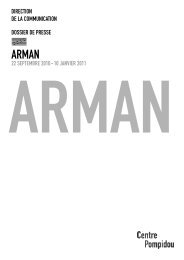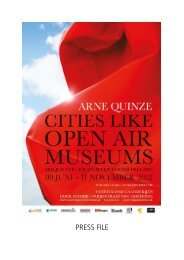Arman - Vicky David Gallery
Arman - Vicky David Gallery
Arman - Vicky David Gallery
Create successful ePaper yourself
Turn your PDF publications into a flip-book with our unique Google optimized e-Paper software.
9<br />
1971-1978<br />
On 25 January 1971 <strong>Arman</strong> is divorced from Éliane Radigue, and on 13 July he marries Corice Canton<br />
in Nice. <strong>Arman</strong> returns to the Poubelles (Garbage Can) series, embedding the trash in a single block<br />
of transparent resin: he makes the series of Organic Garbage Cans, in this way avoiding the sorting that<br />
had been necessary for reasons of conservation. These works testify to the explosive growth and<br />
Americanisation of modern consumption. On 31 January 1972, <strong>Arman</strong> becomes an American citizen,<br />
taking the name of <strong>Arman</strong>d Pierre <strong>Arman</strong>. He begins to practice kung-fu with his wife Corice. Impressed<br />
by its power and overconsumption, <strong>Arman</strong> decides to make a portrait of New York and invites his friend<br />
the director Jean-Pierre Mirouze to come and make a film (Sanitation) on the city and its garbage. In 1974,<br />
<strong>Arman</strong> works on several monumental schemes of architectural decoration and the Daniel Templon gallery<br />
in Paris shows the Organic Garbage Cans. Lined up and standing on plinths, these exercise a cunningly<br />
calculated attraction-repulsion on the viewer. In September-October 1974, a major touring retrospective<br />
opens at the Museum of Contemporary Art in La Jolla (California) covering all <strong>Arman</strong>’s activity between<br />
1958 and 1974. In January 1975, the Musée d’Art Moderne de la Ville de Paris exhibits Coupes and Colères<br />
embedded in concrete under the title “Objets armés.” The concrete introduces constraints that require<br />
a more carefully considered composition, while the work acquires a monumental, surreal character.<br />
At 7 pm on 5 April 1975 <strong>Arman</strong> carries out the Conscious Vandalism action at the John Gibson <strong>Gallery</strong>,<br />
New York, destroying the apartment contents carefully installed there. In 1977, the Centre Pompidou pays<br />
tribute to the École de Nice at its opening and <strong>Arman</strong> has a crucial place in this exhibition.<br />
1979-1988<br />
<strong>Arman</strong> produces his first work directly related to architecture, Accumulation fallopienne. He decides<br />
to give up the game of Go despite having attained the rank of 1st dan amateur, as the time and effort<br />
required is too great. For the same reason, he sells his collection of African art, keeping only the more<br />
important pieces. In 1982, Jean Hamon buys the Château du Montcel at Jouy-en-Josas; there <strong>Arman</strong><br />
creates Long Term Parking, a large volume of concrete, 2,000 tons in weight and 18 metres in height,<br />
embedded in which are 64 cars. <strong>Arman</strong>, who has had more than 160 one-person shows across the world<br />
in less than thirty years, sees his first French retrospective open at the Musée Picasso in Antibes in July<br />
1983. The high point of the show is an accumulation of thirty guitars in bronze called À ma jolie,<br />
a reworking of Picasso’s Cubist paintings of 1912. On 14 July 1984, À la République, a monumental piece<br />
more than 3 metres high and 5 tons in weight, representing an accumulation of 200 flags, is inaugurated<br />
in the hall of honour of the Élysée Palace, official residence of the French president. The Marisa del Re<br />
<strong>Gallery</strong> shows The Day After, a combustion of a whole room of furniture in the Louis XV style, cast in bronze:<br />
by the destruction of these domestic furnishings <strong>Arman</strong>, always fascinated by catastrophe, alluded to the<br />
possible annihilation of our way of life. In 1985, he embarks on his first series of paint tubes on canvas,<br />
and creates a gigantic accumulation of 2,300 washing-machine drums in his house at Vence. In June 1988,<br />
<strong>Arman</strong> organises a happening on the stage of the People’s Palace on Tien An Men Square, in Beijing:<br />
the Paris Opera Orchestra plays Beethoven’s String Quartet N° 16 as he smashes up musical instruments<br />
to produce a rage piece, Beijing Quartet #1, the work being performed in tempo and in time. Organised for<br />
the benefit of the “Save the Great Wall of China” campaign, this event was for <strong>Arman</strong> the most memorable<br />
of his whole career.<br />
1989-1997<br />
In New York in 1989, <strong>Arman</strong> embarks on the series of Shooting Paintings and Dirty Paintings. The new<br />
techniques respond to a desire to work again with paint, evident as early as 1987 (Brushing Paintings):<br />
“I am a born-again painter,” he says. He works simultaneously on three series the Dirty Paintings, the<br />
Color Scales and Under the Skin: these last are paintings that combine objects (squeezed paint tubes in<br />
monochromatic compositions over other objects) and stratified layers of paint. He also begins the Atlantis<br />
series, casting a variety of objects in bronze and including sand and other substances in the mould to give<br />
the impression of a long immersion under the sea. Introduces the bicycle theme into the Shooting Paintings.<br />
Especially prolific, he returns in New York to the theme of accumulations, developed as accumulations of<br />
collections. Mémoires accumulés, a book of interviews with <strong>Arman</strong> by Otto Hahn, is published by Éditions<br />
Belfond in October 1992. Alongside his sculptures he makes several variations on Van Gogh’s Starry Night<br />
(1889), shown in 1994. The following year, the Georges-Philippe and Nathalie Vallois gallery shows<br />
a selection of the Renault Accumulations. On 2 August, Hope for Peace, a monumental 32-metre high<br />
accumulation that has 83 tanks embedded in 6,000 tons of concrete, is inaugurated in Beirut. Restany<br />
remarks that the monument could not better express the spirit of this city battered by civil war.




